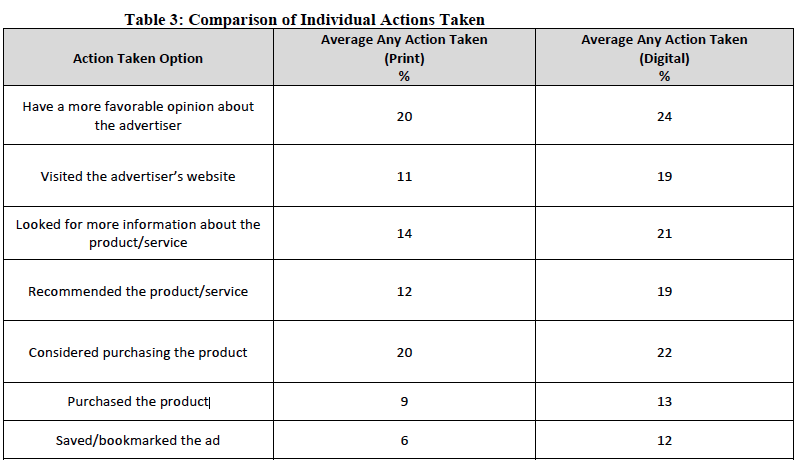Delving Into the Opportunity for Tablet Magazine Advertising - An Analysis of the GfK Starch Data
By Michal Galin, Jana Slaten, Valerie Veith, and Britta Cleveland
Magazines
"Readers remember ads on tablets at the same rate as in print, yet the digital platform makes it easier to take action as a result of seeing ads."
Source: Delving Into the Opportunity for Tablet Magazine Advertising – An Analysis of the GfK Starch Data. Michal Galin, Jana Slaten, Valerie Veith (GfK MRI) and Britta Cleveland, Meredith Corporation. Presented at the Print and Digital Research Forum Symposium 2013 in Nice, France October 13-16, 2013
Activity Tested: Consumer recall and response to digital tablet ads versus print ads.
Method: Ongoing online consumer survey between March 2012 and May 2013.
Measures: GfK MRI's Starch Digital's survey measures consumer recall of and response to digital ads across hundreds of issues of digital consumer magazines.
Key readership metrics include: reader demographics, the percentage of readers who "noted" a digital advertisement, how well an ad was read ("read any" and "read most" ratings), and actions taken as a result of reading a digital advertisement (purchase, intention to buy, recommended product, etc.) Digital Starch also queried respondents about their engagement with interactive features found within specific ads.
Sample: Starch Digital measures title-specific data from every ad in every issue of scores of leading consumer magazines on Tablets, eReaders and in digital reproductions. A total of 27,162 tablet (Apple iPad) ads measured between March 2012 and May 2013 were analyzed. In addition, to offer a more apples-to-apples analysis, for the purpose of illustration, Starch analyzed the same 44 titles measured in print versus their digital counterpart.
Results:
Interactive Features Offered
-
Of the 27,162 tablet ads, 14,570 (almost 54%) included no interactive features.
-
50.1% (13,600 ads) linked to the advertised brand’s website.
-
3.9% (1,045 ads) linked the reader to the brand's social media presence
-
1.3% (346 ads) provided links to a video or commercial
-
0.5% (134 ads) offered a downloadable app
-
0.1% (29 ads) linked to a game to play.
Comparison of Print vs. Digital Ad Performance
-
Ads found in digital magazines vs. printed magazines had nearly the same rate of reader recall of the ad – with a slight edge to digital, 53% versus 51%.
-
Readers of digital editions took action at a higher rate after seeing ads (72% versus 57%, overall), including recommendations to friends and family and actual purchase. This is statistically significant at the 95% confidence level.

Source: Starch Digital, 2013
Does Interactivity Enhance Ad Response?
-
The top line data indicate that the mere presence of interactive features in ads does not seem to influence the performance of the ad overall; static ads vs. Interactive had similar recall (55% v. 52%) and action (73% v. 71%) results.
-
Examining the 14,570 ads with interactive features in detail, interactive features such as a picture gallery, multiple pages of ad content, interacting with the ad by moving/turning the device, and watching a video or commercial, impacted the recall of an ad more so than other features.
-
Overall, ads that feature more interactive features performed better.

Source: Starch Digital, 2013 -
With that said, the authors asked the question, "Does incorporating interactivity into any/every ad make sense?" Looking at various product categories, at the time of this analysis automotive and finance took advantage of interactivity more so than other product categories and both categories seemed to benefit from the inclusion of interactivity in ads; that is, "when the interactivity benefits the overall message or is consistent with the message, it tends to work better."
-
As an example: the data shows that when interactivity is included in a finance ad, the ad performs better than when interactivity is not present – 57% recall vs. 47%.
-
Examining a specific finance ad by TD Ameritrade, which ran in spring 2013 in Bloomberg Businessweek and included a game, analysis found 65% of the readers of this tablet issue remembered seeing the ad and 25% of those played the game.
Take-Aways:
When reviewing recall and actions taken, digital ads have an impact at least on par with print ads and sometimes perform higher; the digital platform makes it easier to take action as a result of seeing ads. This is demonstrated by the overall higher action taken scores in digital versus print. The authors note that, "While there is great curiosity about the efficacy of interactivity, the inclusion of interactive features within ads is still at its infancy. Certain product categories seem to have come out of the gate quickly incorporating such features into their creative. Others have been slower to go in this direction. Those who have incorporated such features into their ads have seen some positive benefit."
Should advertisers be investing dollars to place ads in the digital editions of print brands? Is there a difference between the effectiveness of content in print versus digital representations of print brands? The authors feel their analysis and effort scratches the surface of digital ad effectiveness and look to further opportunities for future analysis.
Complexity rating of original source: 1 (Complex statistical analysis scale: 1= easy, 2= moderate, 3 = difficult)
Link to PDF of Delving Into the Opportunity for Tablet Magazine Advertising – An Analysis of the GfK Starch Data.





